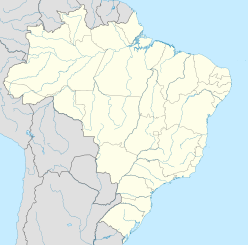Serra da Cangalha
| Serra da Cangalha | |
|---|---|
Tocantins | |
Serra da Cangalha is an
Description
The outer perimeter is a circular inward scarp about 12 kilometres (7.5 mi) in diameter on the largely undisturbed Cretaceous and upper Silurian sediments of the Parnaíba basin,[4] breached on the west, north, and south sides by drainage valleys. Within the perimeter there is a series of concentric circular valleys and a central basin, all at roughly the same elevation, separated by ring walls. Shuttle Radar Topography Mission imagery shows a faint ring about 11 kilometres (6.8 mi) in diameter, a second ring of gentle hills about 5 to 6 kilometres (3.1 to 3.7 mi) in diameter, and an inner ring of steeper hills, about 3 kilometres (1.9 mi) in diameter and up to 420 metres (1,380 ft) high, open to the northwest, surrounding a central basin about 2.2 kilometres (1.4 mi) in diameter.[5][6][7]
The impact origin is attested by the presence of
History and studies
The identification of the structure as an impact crater was first published in 1973 by R.S. Dietz and B.M. French.[10][11] Shatter cones were reported by Beatty in 1980.[12] Impact breccias, impact melting, and shocked quartz were reported by McHone in his 1986 thesis.[13] A magnetic survey of the structure was published by A.A. Adepelumi and others in 2005.[6]
See also
References
- ^ "Serra da Cangalha". Earth Impact Database. Planetary and Space Science Centre University of New Brunswick Fredericton. Retrieved 2017-10-09.
- Bibcode:1992LPI....23..887M.
- ^ a b R. Almeida Filho; F.R. Moreira; C.H.Beisl (2003). "The Serra da Cangalha astrobleme as revealed by ASTER and SRTM orbital data" (PDF). International Journal of Remote Sensing. 24: 1–6. Archived from the original (PDF) on 2011-07-06. Retrieved 2007-09-24.
- .
- ^ a b R. Gregio. "Cratera da Serra da Cangalha". Archived from the original on 2007-09-30. Retrieved 2007-09-24.
- ^ .
- ^ a b W.U. Reimold; G.R.J. Cooper; R. Romano; D. Cowan; C. Koeberl (2004). "A SRTM Investigation of Serra da Cangalho [sic] Impact Structure, Brazil" (PDF). Lunar and Planetary Science XXXV. Retrieved 2007-09-24.
- ^ W. Masero; P.-A. Schnegg; S.L. Fontes. "Magnetotelluric investigation of the Serra da Cangalha impact crater, Northeast Brazil".
{{cite journal}}: Cite journal requires|journal=(help) - ^ Adekunle Adepelumi; Jean M. Flexor; Sergio L. Fontes; Pierre-A. Schnegg. A magnetotelluric investigation of the Serra da Cangalha impact crater structure, Brazil.
- S2CID 4167202.
- ISBN 978-3-663-01891-9.
- Bibcode:1980S&T....59..464B.
- ^ McHone J. F. (1986). Terrestrial impact structures: Their detection and verification with new examples from Brazil. University of Illinois at Urbana-Champaign, Urbana, Illinois. p. 210.



